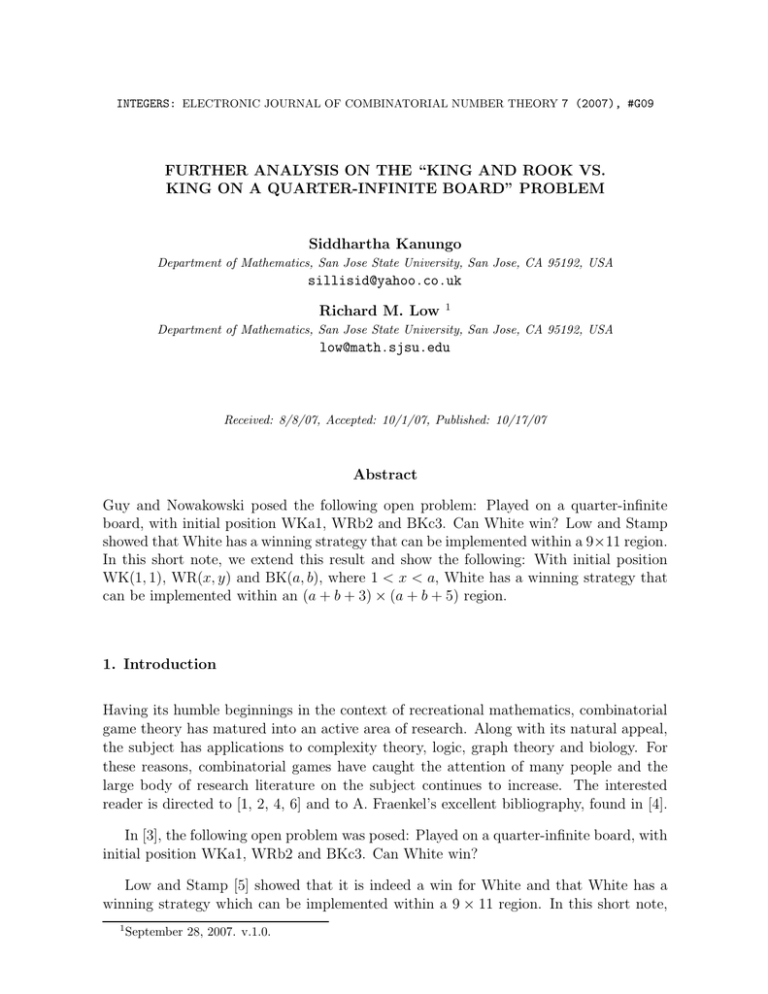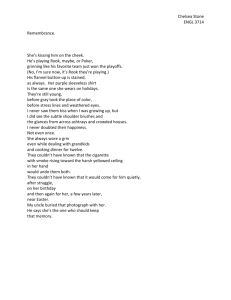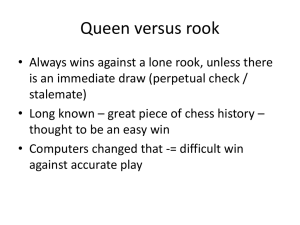FURTHER ANALYSIS ON THE “KING AND ROOK VS. Siddhartha Kanungo
advertisement

INTEGERS: ELECTRONIC JOURNAL OF COMBINATORIAL NUMBER THEORY 7 (2007), #G09 FURTHER ANALYSIS ON THE “KING AND ROOK VS. KING ON A QUARTER-INFINITE BOARD” PROBLEM Siddhartha Kanungo Department of Mathematics, San Jose State University, San Jose, CA 95192, USA sillisid@yahoo.co.uk Richard M. Low 1 Department of Mathematics, San Jose State University, San Jose, CA 95192, USA low@math.sjsu.edu Received: 8/8/07, Accepted: 10/1/07, Published: 10/17/07 Abstract Guy and Nowakowski posed the following open problem: Played on a quarter-infinite board, with initial position WKa1, WRb2 and BKc3. Can White win? Low and Stamp showed that White has a winning strategy that can be implemented within a 9×11 region. In this short note, we extend this result and show the following: With initial position WK(1, 1), WR(x, y) and BK(a, b), where 1 < x < a, White has a winning strategy that can be implemented within an (a + b + 3) × (a + b + 5) region. 1. Introduction Having its humble beginnings in the context of recreational mathematics, combinatorial game theory has matured into an active area of research. Along with its natural appeal, the subject has applications to complexity theory, logic, graph theory and biology. For these reasons, combinatorial games have caught the attention of many people and the large body of research literature on the subject continues to increase. The interested reader is directed to [1, 2, 4, 6] and to A. Fraenkel’s excellent bibliography, found in [4]. In [3], the following open problem was posed: Played on a quarter-infinite board, with initial position WKa1, WRb2 and BKc3. Can White win? Low and Stamp [5] showed that it is indeed a win for White and that White has a winning strategy which can be implemented within a 9 × 11 region. In this short note, 1 September 28, 2007. v.1.0. INTEGERS: ELECTRONIC JOURNAL OF COMBINATORIAL NUMBER THEORY 7 (2007), #G09 2 we extend this result and show the following: With initial position WK(1, 1), WR(x, y) and BK(a, b), where 1 < x < a, White has a winning strategy which can be implemented within an (a + b + 3) × (a + b + 5) region. Since the original problem does not specify who moves first, we assume that White moves first. In this paper, every square of the quarter-infinite board is described as an ordered pair (x, y), where x, y ≥ 1. A column is called a file and a row is called a rank. Also, let (WKsi , WRsj , BKsk ) denote the game position where the White King is on square si , the White Rook is on square sj , and the Black King is on square sk . 2. White’s Strategy Definition. Suppose that Black’s King is trapped inside a rectangular region of finite area, and that White’s King is protecting its Rook. We say that this is a winning position for White. !! +., !* +, ) ( ' & % $ # " ! ! " # $ % & ' ( ) Figure 1: This is a winning position for White. White’s strategy is simple. His goal is to obtain a winning position. Once this has been achieved, White proceeds in the following way: Using his King and Rook, he systematically decreases the size of the rectangular region and eventually checkmates the Black King in an area close to the (1,1) square. For example, suppose that White has trapped Black in the following position: (WK(5,3), WR(4,4), BK(3,3)) with White to move. Then, 1. K(5,4) K(2,3); 2. K(4,3) K(2,2); 3. R(3,4) K(2,3); 4. K(4,4) K(2,2); 5. R(3,3) K(2,1); 6. K(4,3) K(2,2); 7. K(4,2) K(2,1); 8. R(3,2) K(1,1); 9. K(3,3) K(2,1); 10. K(2,3) K(1,1); 11. R(3,1), and Black’s King is checkmated. INTEGERS: ELECTRONIC JOURNAL OF COMBINATORIAL NUMBER THEORY 7 (2007), #G09 3 Can White ever hope to obtain a winning position? At first glance, it seems as if this might not be possible. 3. Various Black Strategies Since Black does not wish to lose, there are several strategies which he might employ. For example, Black can attempt to run off towards infinity. Of course as Black’s King is trying to run away, White’s Rook can easily contain it in a rectangular region of finite area. In this case, Black’s King moves toward the White Rook to chase it away. This eventually forces the White Rook to move away, which results in a larger enclosed region in which Black’s King can move in. Conceivably, Black can proceed in like manner, ad infinitum. The following theorem shows that Black cannot do this in a naive fashion. Theorem 1. If Black’s King attempts to run away towards infinity (by increasing its x and y coordinates whenever possible), White obtains a winning position. Proof. 1. R(x, a + b + 5) K(a + 1, b + 1); 2. R(a + 2, a + b + 5) K(a + 1, b + 2); 3. K(2,2) K(a + 1, b + 3). After another a + 1 pairs of moves, the game position is (WK(a + 3, a + 3), WR(a+2, a+b+5), BK(a+1, a+b+4)), with Black attacking the White Rook (see Figure 2). The game continues with 4. R(a + b + 3, a + b + 5) K(a + 2, a + b + 4); 5. K(a + 4, a + 4) K(a + 3, a + b + 4); 6. K(a + 5, a + 5) K(a + 4, a + b + 4). Continuing in like manner, the position (WK(a+b+2, a+b+2), WR(a+b+3, a+b+5), BK(a+b+1, a+b+4)) is arrived at, with White to move (see Figure 3). White continues with K(a + b + 3, a + b + 3). At this point, White can easily obtain a winning position. A related strategy that Black might try is to always aggressively move his King towards the White Rook. However, this is a losing strategy for Black. Theorem 2. If Black’s King always moves toward the White Rook, White obtains a winning position. Proof. No matter what Black does, White’s first and second moves should be R(x, a + b + 5) and R(a + 2, a + b + 5), respectively. Then, White’s King should continue to move diagonally up and to the right, as described in the proof of Theorem 1. White easily obtains a winning position. Yet another strategy that Black might try is to attempt to hem in the White King so as to prevent it from ever being able to protect the White Rook. Unfortunately (for Black), this is not possible. Theorem 3. The White King cannot be hemmed in and rendered harmless. INTEGERS: ELECTRONIC JOURNAL OF COMBINATORIAL NUMBER THEORY 7 (2007), #G09 !"%"' !"%"& 4 (* +) !"$ () !"# !"$ Figure 2: Proof. As before, White’s first and second moves should be R(x, a + b + 5) and R(a + 2, a + b + 5), respectively. Whatever the Black King does, White’s goal is to move the White King to the right of the Black King, yet staying as close as possible to it. This can be accomplished since the Black King is to the left of the White Rook (after White’s second move) and the White King can eventually move to the right side of the White Rook. At that point, White’s King is ready to join in the fray. Definition. Let White’s Rook be on the (a + 2)-file and suppose that Black’s King is trapped inside the rectangular region of finite area. If White’s King is on the xi -file where xi ≥ a + 2, then the White King is active (and has been activated ). Note that Theorem 3 shows that White’s King can always be made active. 4. Victory for White White’s first and second moves should be R(x, a+b+5) and R(a+2, a+b+5), respectively. The general strategy for White is to activate the White King and race towards (a+4, a+4). If Black plays passively, White has no difficulty in obtaining a winning position. Thus, Black must aggressively attack White’s Rook. In the various scenarios which can occur, a key position is reached (see Figure 4). Here, White easily obtains a winning position within an (a + b + 5) × (a + b + 3) region (even if it is Black’s turn to move). Notation. Suppose that the White King, White Rook and Black King are in a (legal) INTEGERS: ELECTRONIC JOURNAL OF COMBINATORIAL NUMBER THEORY 7 (2007), #G09 !"#"' !"#"& 5 (* +) () !"#"$ !"#"% Figure 3: White to move, wins in this position. position on the quarter-infinite board. Let DW (si ) denote the minimum number of consecutive (legal) moves the White King must make to reach square si , assuming that Black does not move. For the Black King, DB (sj ) is defined in a similar fashion. Lemma 1. Suppose that White’s Rook is on square (a + 2, a + b + 5), with the Black King inside the rectangular region of finite area (ie. the Black King is on a square on the xi -file, where xi < a + 2, and also on the yi-rank, where yi < a + b + 5). If DW ((a + 4, a + 4)) ≤ DB ((a + 1, a + b + 4)), then White can obtain a winning position. Proof. Without loss of generality, we can assume that White’s King is active. Let us consider the worst case scenario. In this case, it is Black’s turn to move. Now if Black plays passively and does not attempt to attack the Rook, then White easily obtains a winning position by bringing its King to (a + 3, a + b + 4). Thus, Black must march its King towards (a + 1, a + b + 4). As Black does this, White’s King moves toward (a + 4, a + 4). CASE (i). The White King arrives at (a + 4, a + 4) before the Black King arrives at (a + 1, a + b + 4). In this case, White easily obtains a winning position by moving his King to (a + b + 3, a + b + 4) and his Rook to (a + b + 3, a + b + 5). CASE (ii). The White King is one move away from (a + 4, a + 4) and the Black King is on (a + 1, a + b + 4). In this case, 1. R(a + b + 3, a + b + 5) K(a + 2, a + b + 4); 2. K(a + 4, a + 4) and White can obtain a winning position (see Figure 5). Theorem 4. With initial position (WK(1, 1), WR(x, y), BK(a, b)) where 1 < x < a, White can obtain a winning position within an (a + b + 3) × (a + b + 5) region. INTEGERS: ELECTRONIC JOURNAL OF COMBINATORIAL NUMBER THEORY 7 (2007), #G09 *+ !"$"' !"$"& 6 () !"& *) !"# !"& !"$"% Figure 4: This is a key position. Proof. White’s first move is 1. R(x, a + b + 5), followed by 2. R(a + 2, a + b + 5). White then aggressively activates his King, with the goal of having his King reach (a + 4, a + 4) as quickly as possible. Once White satisfies the hypothesis of Lemma 1, Black will lose. 1. The Black King moves around passively. If Black allows the White King to move to (a + 3, a + b + 4) [without trying to hem in the White King or chase away the White Rook from (a + 2, a + b + 5)], then White obtains a winning position. 2. The Black King tries to run off to infinity. There are several ways that Black can do this. The worst case scenario (for White) is described in Theorem 1, where White eventually obtains a winning position. All other attempts by Black to run off to infinity yield positions which satisfy the hypothesis of Lemma 1, where White eventually obtains a winning position. 3. The Black King tries to hem in the White King. Theorem 3 shows that this is not possible. Again, White aggressively activates his King, while racing towards (a+4, a+4). Throughout this, the White King always stays as close as possible to the Black King. White easily obtains a position which satisfies the hypothesis of Lemma 1, leading to a win for White. Note that in some variations, positions such as (WK(a − 1, s), WR(a + 2, a + b + 5), BK(a + 1, s)) with White to move, might occur. In these cases, White continues with R(a + 2, a + b + 4). Play continues with the White King racing towards (a + 4, a + 3) and Black racing towards (a + 1, a + b + 3) to drive the White Rook away. When the Black King reaches (a+1, a+b+3), the White Rook moves to (a+b+3, a+b+4). White easily obtains a winning position. INTEGERS: ELECTRONIC JOURNAL OF COMBINATORIAL NUMBER THEORY 7 (2007), #G09 *+ !"$"' !"$"& 7 () !"& *) !"# !"& !"$"% Figure 5: With Black to move, White still obtains a winning position. Corollary 1. With initial position (WK(x1 , y1 ), WR(x, y), BK(a, b)) where x1 < x < a, y1 < b, White can obtain a winning position within an (x1 −1+a+b+3)×(y1 −1+a+b+5) region. References 1. Berlekamp, E.R., Conway, J.H. and Guy, R.K., Winning Ways for your Mathematical Plays (four volumes), A.K. Peters, 2001. 2. Conway, J.H., On Numbers and Games, Academic Press, London, 1976. 3. Guy, R.K. and Nowakowski, R.J., Unsolved problems in combinatorial games, More Games of No Chance (Berkeley, CA, 2000), 457–473, Math. Sci. Res. Inst. Publ., 42, Cambridge Univ. Press, Cambridge, 2002. 4. Guy, R.K. and Nowakowski, R.J., More Games of No Chance (Berkeley, CA 2000), Math. Sci. Res. Inst. Publ., 42, Cambridge Univ. Press, Cambridge, 2002. 5. Low, R.M. and Stamp, M., King and rook vs. king on a quarter-infinite board. Integers. 6 (2006), #G3, 8pp. (electronic). 6. Nowakowski, R.J., Games of No Chance (Berkeley, CA, 1994), Math. Sci. Res. Inst. Publ., 29, Cambridge Univ. Press, Cambridge, 1996.







